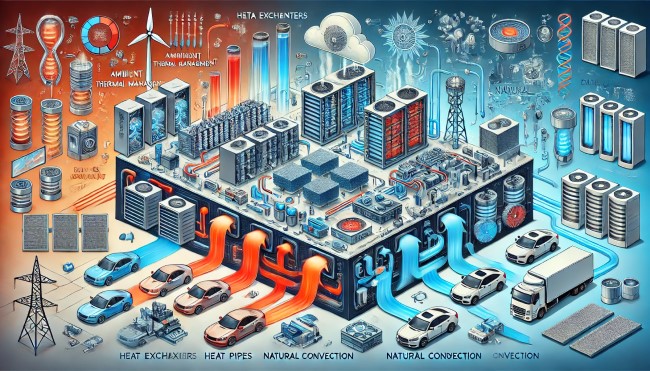Ambient Thermal Management: A Comprehensive Guide to Efficient Heat Control

In today’s tech-driven world, managing heat in electronic devices, industrial systems, and even data centers has become crucial to ensuring long-lasting performance and efficiency. One of the most effective ways to achieve this is through ambient thermal management, a method that leverages the surrounding environmental temperature to regulate heat without the need for energy-intensive solutions like air conditioning or active cooling systems.
This article delves into the intricacies of ambient thermal management, exploring its benefits, key mechanisms, and applications. By the end, you will have a thorough understanding of how this approach not only helps maintain system performance but also contributes to energy conservation and cost reduction.
What is Ambient Thermal Management?
Ambient thermal management refers to the practice of controlling heat by utilizing the surrounding ambient temperature to dissipate excess heat generated within a system. Unlike traditional thermal management methods that require active components such as fans, air conditioners, or liquid cooling systems, ambient thermal management relies primarily on natural convection and conduction processes. The goal is to maintain the temperature of electrical components and systems at or just above ambient levels.
Key Components of Ambient Thermal Management:
- Heat Exchangers: Devices that transfer heat from a hot component to a cooler surrounding environment.
- Heat Pipes: Efficient devices that use the principles of conduction and phase change to transfer heat.
- Cold Plates: Plates that absorb heat from hot components and dissipate it into the environment.
The Importance of Ambient Thermal Management
The importance of ambient thermal management has grown as the world shifts towards denser, more powerful, and energy-efficient electronics. As electronic components and industrial systems generate more heat due to increased processing power and activity, they face a heightened risk of overheating. Overheating can cause hardware failures, reduce operational efficiency, and lead to costly downtime.
In addition to hardware protection, ambient thermal management helps reduce the energy consumption of active cooling systems like air conditioners, which are not only expensive to operate but also harmful to the environment due to their high energy requirements.
Key Benefits:
- Energy Efficiency: Minimizing the reliance on active cooling methods leads to substantial energy savings.
- Cost Savings: Reducing energy consumption lowers operational costs.
- Increased Lifespan: By preventing overheating, components last longer.
- Environmental Impact: Passive cooling systems are eco-friendly as they use less electricity and produce fewer greenhouse gas emissions.
Mechanisms of Ambient Thermal Management
There are three fundamental methods through which ambient thermal management controls heat: conduction, convection, and radiation. Each method transfers heat differently and can be used in various combinations depending on the system’s requirements.
Conduction
Conduction is the transfer of heat through direct physical contact between two objects of different temperatures. Heat moves from the hotter object to the cooler one until thermal equilibrium is achieved. In ambient thermal management systems, materials with high thermal conductivity (such as metals) are used to enhance the conduction process.
Example: Heat pipes are a popular conduction-based solution in electronics. They quickly transfer heat away from hot components like CPUs, allowing the system to stay cool.
Convection
Convection is the transfer of heat through the movement of air or fluid. This can occur naturally (natural convection) or with the aid of fans (forced convection). Ambient thermal management primarily relies on natural convection to move heat from the interior of a system to the surrounding environment.
Example: Heat exchangers utilize natural convection to transfer heat from inside a sealed electrical enclosure to the outside environment.
Radiation
Radiation is the transfer of heat through electromagnetic waves. While radiation is less effective in typical thermal management scenarios, it plays a role in specific cases, such as cooling systems exposed to vacuum environments where conduction and convection are not feasible.
Example: Radiation cooling is used in space applications where electronic components must radiate heat away into space.
Applications of Ambient Thermal Management
Ambient thermal management can be applied across various industries, from electronics and data centers to industrial machinery. Below are a few key sectors where it is making a significant impact:
Data Centers
Data centers are some of the largest consumers of energy due to the vast amounts of data processing and storage they handle. Ambient thermal management helps reduce the need for energy-intensive cooling systems in data centers, using natural convection and heat exchange techniques to regulate temperature. As a result, operational costs and environmental impact are minimized.
Industrial Machinery
Heavy machinery in industrial settings generates a significant amount of heat, and maintaining these systems at optimal operating temperatures is essential for performance and safety. Ambient thermal management solutions such as heat exchangers and heat sinks help manage heat without requiring constant air conditioning, leading to lower energy usage and fewer breakdowns.
Electronics
In consumer electronics, ambient thermal management is vital to keep devices like smartphones, laptops, and gaming consoles from overheating during use. Heat sinks and heat pipes are commonly employed to dissipate heat from high-performance processors and GPUs, ensuring that devices remain functional even under heavy loads.
Automotive
As electric vehicles (EVs) become more prevalent, the demand for efficient thermal management solutions has increased. EV batteries generate considerable heat, and ambient thermal management can help maintain battery temperature within safe limits without consuming excessive energy, which is particularly important for extending the driving range of EVs.
Challenges and Considerations
While ambient thermal management offers numerous benefits, it is not without its challenges. One of the primary concerns is its dependency on external environmental conditions. In areas with high ambient temperatures, the effectiveness of ambient cooling may be limited. As such, systems may need to be designed with hybrid solutions that combine ambient and active cooling methods.
Other Considerations:
- System Design: The layout of components and the materials used are critical to the effectiveness of ambient thermal management.
- Maintenance: While passive cooling systems require less maintenance than active ones, regular checks are still necessary to ensure that heat exchangers and other components are functioning optimally.
- Scalability: For larger systems, like data centers, ambient thermal management solutions need to be scalable and capable of handling significant heat loads.
Future of Ambient Thermal Management
As the world continues to demand more energy-efficient and eco-friendly solutions, ambient thermal management is expected to play an even more prominent role in the future. Advances in materials science, such as the development of higher thermal conductivity materials and more efficient heat exchangers, will further enhance the capabilities of ambient cooling systems.
In addition, the integration of smart technologies that monitor and adjust thermal management processes in real-time will enable even greater efficiency and cost savings. These innovations will be particularly important in high-tech industries, such as artificial intelligence (AI) processing, 5G telecommunications, and electric vehicles.
Conclusion
Ambient thermal management is a key component of modern thermal regulation strategies, offering a more energy-efficient, cost-effective, and eco-friendly alternative to traditional active cooling methods. By leveraging natural processes like conduction, convection, and radiation, ambient thermal management systems can keep electronic components and industrial systems cool while reducing energy consumption and extending the lifespan of equipment.
As industries continue to prioritize sustainability and energy efficiency, the demand for ambient thermal management solutions will only increase. Whether in data centers, industrial machinery, or consumer electronics, this approach provides an effective way to manage heat while minimizing environmental impact.
By understanding and implementing ambient thermal management solutions, businesses can achieve significant cost savings, enhance performance, and reduce their carbon footprint, positioning themselves for a more sustainable future.



